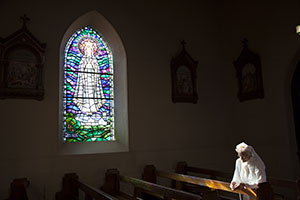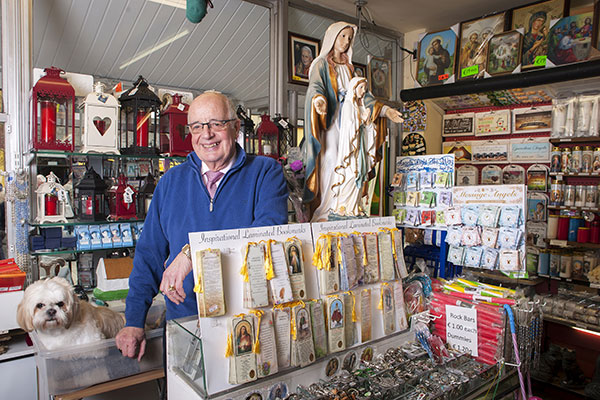Strange occurrences in a small Irish village
Published in Issue 2 (March/April 2017), Reviews, Volume 25Underground Films, RTÉ1, 21 December 2016
By John Gibney

Above: Mary Neary at prayer—one of the distinctive lay guardians of the Knock shrine. (Lindsay Campbell/Underground Films)

Above: Mary Neary at prayer—one of the distinctive lay guardians of the Knock shrine. (Lindsay Campbell/Underground Films)
The obvious question is: what relevance might such a shrine have to 21st-century Ireland, especially given the collapse in the moral authority of a Catholic Church that was formerly one of the pillars of Irish society? This question is at the heart of the film. Kelleher is not interested in probing the veracity or otherwise of the apparitions (the circumstances of which are intriguing in their own right). As with her previous documentary, the focus is on a wide range of individuals associated with the shrine at Knock, from Richard Gibbons, the disarmingly matter-of-fact parish priest, to the distinctive lay guardians of the shrine and their demands that the ‘handmaidens’ receive equal treatment to their male counterparts, not to mention the purveyors of frankly tacky devotional objects (including pictures of former Pope Benedict at a knock-down price) that will be all too familiar to many Irish people of a certain, by no means elderly, age. But if the sale of such items is a testament to a willingness to make a living from the faithful, their existence stems from the faith that they represent. The most striking contributions here are from the faithful themselves, most especially the ill and bereaved, for whom the shrine and the religion it encapsulates offer hope and succour, a fact that should not be lost sight of by lazily dismissing such devotion. It is a great strength of this documentary that it does not lapse into condescension—it lets these stories speak for themselves. Perhaps more could have been done to frame these manifestations of Catholic devotion in modern Irish life, for the devotional practices associated with Knock have ancient roots and it would be a worthwhile exercise to explore how and why the visions originated and survived over the past 130 years (the title itself, after all, is drawn from a contemporary report).

Above: One of the purveyors of frankly tacky devotional objects. (Michael McLaughlin/Underground Films)
Why was this vision reported in Mayo in 1879? What was so special about it? A cynic might suggest that more recent manifestations of the Virgin Mary in Irish life appeared with impeccable timing; the Marian year of 1954 offered a counterweight to the ‘godless’ communism of the early Cold War, while the phenomenon of moving statues in the 1980s could be seen as convenient interventions in bitter debates over abortion and divorce. Mayo in 1879 was scarcely a generation away from the horror of the Great Famine, in which it had been particularly badly affected, and was fast becoming the cradle of the Land League and Land War. Scholars such as Eugene Hynes have located what happened at Knock in such contexts, not to mention in relation to tensions between clergy and laity and the rapidly changing world of rural Ireland in the nineteenth century. How did the vision fit into the vernacular world of the Irish countryside? How was it recast and readopted by the church, given that it languished in obscurity for so long? Yet to demand these additional layers of meaning is perhaps to demand too much. Kelleher’s engrossing and beautifully shot documentary offers a snapshot of the modern iteration of a devotional practice that goes back generations; it is for others to work back from that point.
John Gibney is Education and Outreach Officer at Glasnevin Cemetery Museum.
















